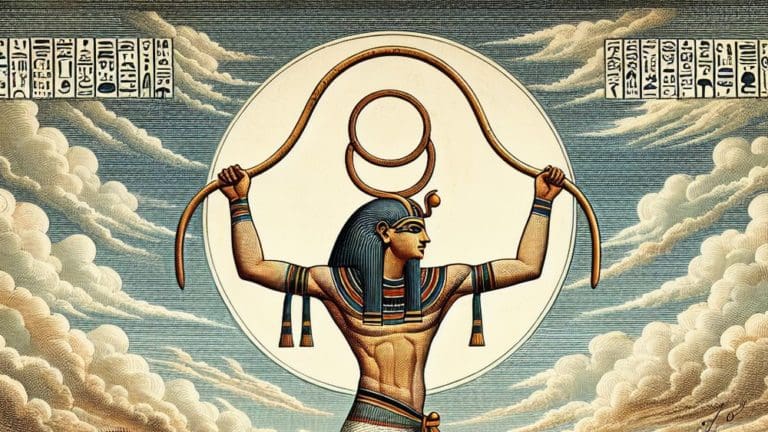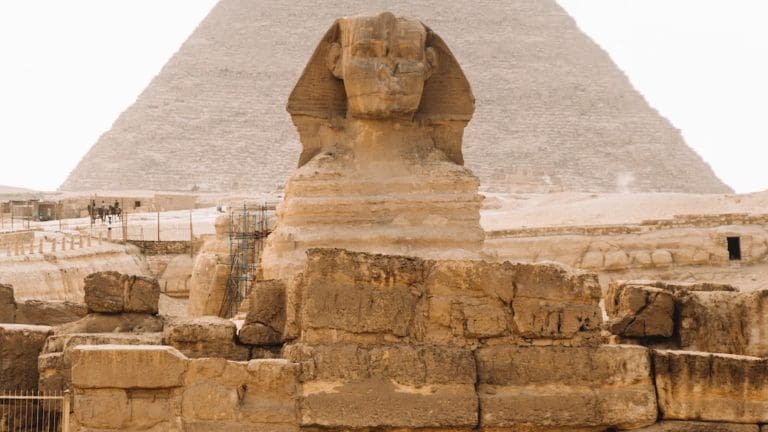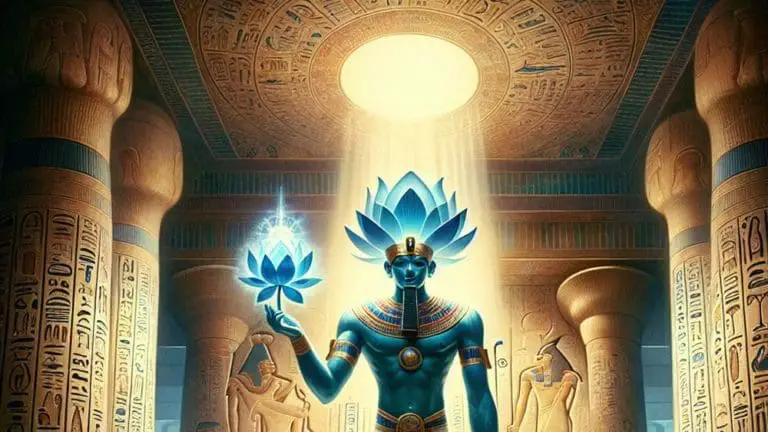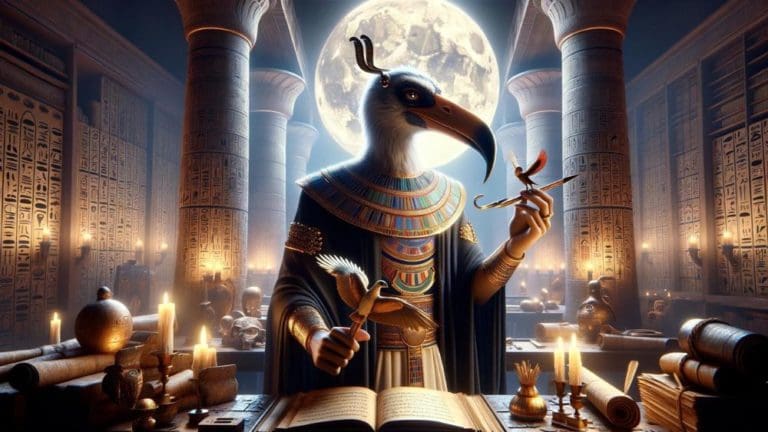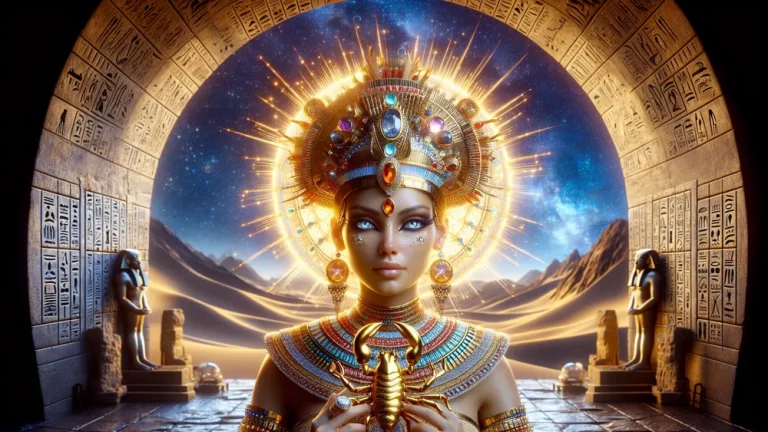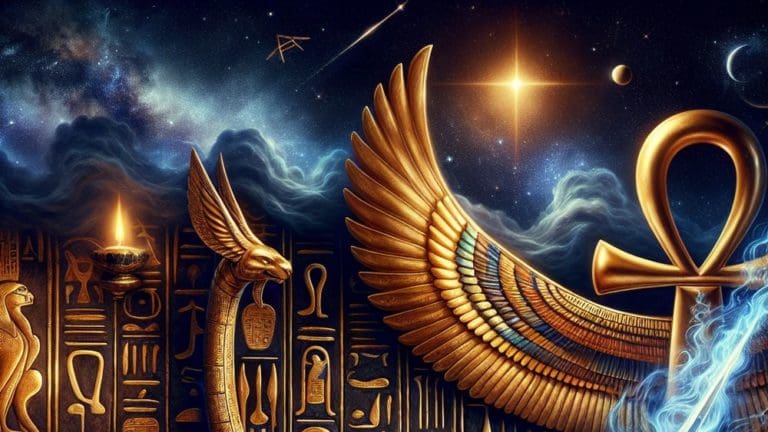Seth: Ancient Egyptian God Of Chaos And Storms
In the world of ancient Egypt, Seth plays a standout role. He’s the god of chaos and storms, which sounds pretty intense. But that’s far from the whole story. Seth also looks after foreigners and loves the desert. It’s a place as wild and unpredictable as he is. Now, when it comes to family drama, Seth’s in the thick of it.
Key Points:
- Seth is the ancient Egyptian god of chaos and storms.
- Seth is known for his complex nature, balancing chaos and order.
- Seth’s family drama involves his brother Osiris and nephew Horus.
- Seth’s worship involved offerings and rituals in places like Ombos and Avaris.
- Seth’s legacy transcends ancient Egypt, influencing later cultures and beliefs.
- Seth’s portrayal and worship evolved over time, reflecting societal changes.
- Seth challenges traditional perceptions of good and evil, representing the balance of existence.
His stories with his brother Osiris and nephew Horus are full of twists and turns. Yet, Seth isn’t all about causing trouble. He’s got a strong side that protects Egypt from dangers lurking in the shadows. Every night, he’s there, making sure the sun god Ra makes it safely through the underworld. This mix of good and bad, creation and destruction, is what ancient Egyptians really dug into.
They saw the world in shades of gray rather than black and white. So for them, Seth was a perfect example of how chaos and order work together. They knew life needs a bit of both to keep the balance right. That’s Seth for you – a god who brings the storm but also fights off the dark, all in a day’s work.
The Origins and Iconography of Seth
Diving into Seth’s backstory and symbols opens up a world where this god shines in all his complexity. His image and what he stood for shifted as the people who honored him changed over time.
Who is Seth in Egyptian Mythology?
So, Seth? He’s the ancient god of chaos, storms, and outsiders in Egyptian tales. His job? Pretty unique. He brings the mess and the mayhem but, believe it or nor, that’s a good thing. It keeps the world balanced. While most gods have a clear-cut nice side, Seth mixes it up. He’s the storm that shakes the calm but also the force that keeps bad at bay.
- Seth’s look is wild. He’s got this animal head that no one can quite pin down. It screams “mystery,” which is so him.
- He’s famous for a rather dark family drama. Seth does the unthinkable and takes out his brother Osiris. This kicks off a whole saga that puts Seth in the spotlight as the guy you love to question.
- Yet, here’s the twist. While he’s doing his chaos thing, he’s also guarding Ra, the sun god, at night. It’s like he’s playing on both teams.
- People in certain parts of Egypt really dug Seth. Places like the Delta and Ombos were all about worshipping him.
- As times changed, so did Seth’s rep. Sometimes he was the villain, especially when peace and order were the day’s top trends.
Seth is a complex character.
He’s got this dual role that keeps you guessing. Is he a hero or a troublemaker? Depends on which story you’re reading. But one thing’s for sure, he keeps the Egyptian myth world spicy and interesting.
Seth, the ancient god of chaos and storms in Egyptian mythology, plays a dual role that keeps the myth world interesting and unpredictable.
Symbols and Representations of Seth
Seth is this ancient Egyptian god who’s all about chaos and storms and such. But when it comes to how folks back then pictured him, well, that’s where it gets really interesting. They had this creature for him, called the Sha animal. Picture this: a beast that’s got a snout that curves, ears that are square, and a tail that splits in two.
Plus, it looks somewhat like a dog but, honestly, it’s like nothing that’s walking around today. This Sha animal is totally Seth’s thing – it screams “I’m different and I don’t fit in a box.” Aside from that, Seth is often seen holding onto an ankh and was scepter. These aren’t your everyday items; they’re super special. The ankh?
That’s about life. The scepter? It screams power. Together, they shout out loud that Seth isn’t all about mayhem; he’s got this side where he’s looking after folks and keeping order too. Now, as time marched on, how people saw Seth and drew him started to change. If they weren’t feeling too friendly towards him, his pictures got a bit more on the scary side and less human-like.
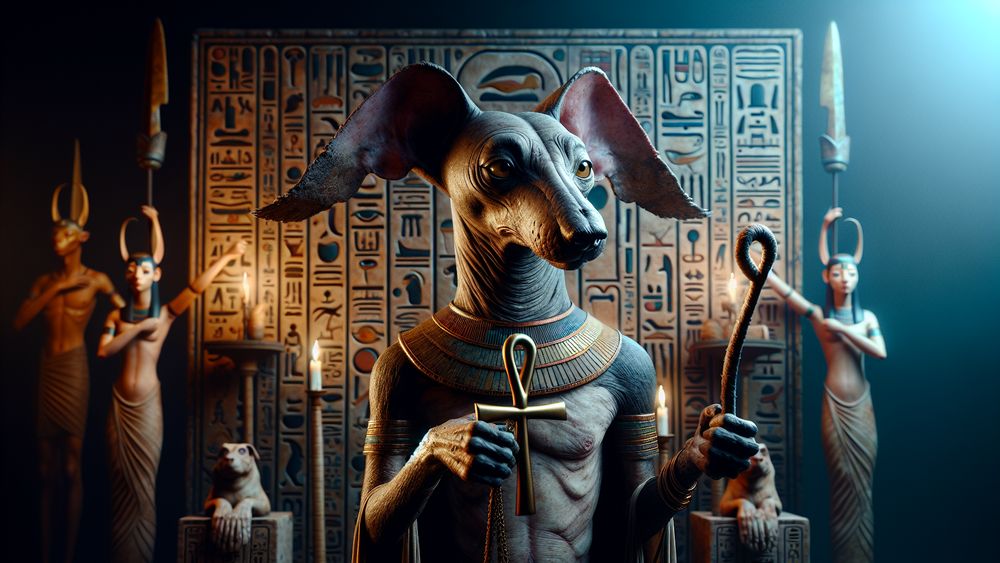
It’s like his image was riding on a roller coaster of public opinion through the ages.
- The Sha animal is unique to Seth and indeed represents his enigmatic nature.
- Ankh and was scepter held by Seth signify his authority and duality in sustaining and disrupting order.
- Changes in Seth’s portrayal over time mirror the fluctuating reverence and disdain towards him in ancient Egyptian society.
- The portrayal of Seth with red hair and eyes was intended to reflect his association with deserts and storms.
So yeah, Seth’s look and what he stood for? It wasn’t set in stone but rather evolved with the times and tales told by the people who either worshipped him or feared him.
Seth’s Role and Stories in Egyptian Mythology
So, we’ve dug into where Seth comes from and the signs that shout his name. Now, let’s jump into the heart of his story and the roles that make him a standout in Egyptian tales. Seth, he’s a figure that catches your eye and keeps you thinking. His stories are a mix, sometimes he’s the hero, and other times, well, it’s complicated.
This part of our talk walks you through those tales where Seth shines and where he stirs the pot.
Seth and His Family Dynamics
In the world of ancient Egyptian myths, Seth’s family ties and feuds are a roller coaster. He’s Osiris and Isis’s brother and Horus’s uncle. Picture this: Seth gets super jealous and decides he wants to be the top dog. So, what does he do? He tricks and kills Osiris, chops him up, and scatters him far and wide.
This brutal act kicks off a massive showdown with Horus, who’s out for revenge for his dad’s murder. The battles between Horus and Seth aren’t your everyday squabbles. They’re epic and filled with drama, ending up in front of the gods’ court for a final decision. In the end, Horus grabs the win, claiming the throne as his rightful place. Seth?
Sometimes he gets punished, but other times, he lands a gig overseeing deserts and foreign lands. This whole saga isn’t just a family feud; it’s about chaos and order, destruction and healing. Seth and his complex relationships show us that even in mythology, families can be messy but also crucial in keeping the universe balanced and interesting.
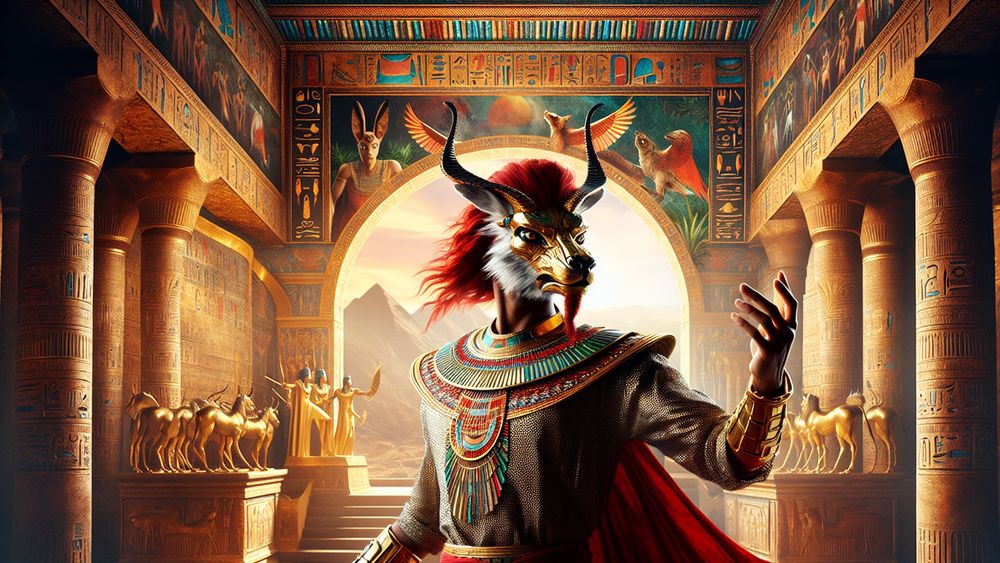
Seth’s jealousy and violent actions against Osiris spark a dramatic and epic showdown with Horus, ultimately leading to a battle for the throne and a reflection on the balance between chaos and order in ancient Egyptian mythology.
Seth’s Dual Nature and Misunderstandings
Seth. He’s a bit of a puzzle in the world of ancient Egyptian gods. Not your run-of-the-mill bad guy, nor is he the hero in shining armor. Picture him more like that one relative who always stirs up drama at family gatherings but also, somewhat surprisingly, saves the day when you least expect it.
Seth tears apart the norm, literally, when he decides to off his brother Osiris. This move slots him into the villain role for many. Yet, there’s another side to him. He’s also the guy standing on the front lines, keeping chaos at bay and fighting off enemies that threaten peace and order. His story isn’t black and white. It’s filled with shades of gray that make you think twice.
While some may quick to label him as the embodiment of evil, the ancient texts and rituals suggest something more nuanced. They show us a deity who plays a critical role in maintaining the balance of the universe. Seth battles the serpent Apophis, which is no small feat, to protect Ra during his nightly underworld adventures.
This isn’t merely about good versus evil; it’s about the essential balance and the complex nature of existence itself. So, when we talk about Seth, let’s remember that his narrative challenges us to look beneath the surface. It invites us to see that destruction and protection are two sides of the same coin, and that even in mythology, characters can’t be neatly boxed into categories of good and evil.
The Worship and Cult of Seth
So, after digging into Seth’s complex stories and roles, we shift gears. Now, it’s time to get into how people showed their love and respect for him. They did more than tell his tales. They lived a devotion that was real and full of actions.
Centers and Practices of Seth’s Worship
In ancient Egypt, Ombos and Avaris shine as the go-to spots for Seth’s fans. Ombos grabs the spotlight for being Seth’s home turf, where folks really show him the love. Avaris, with its unique vibe and history, gives Seth a special twist, mixing in some local flavor. Here, people get creative in how they say thanks and ask for his help.
They’re all about the animal offerings, which isn’t surprising since Seth has a thing for creatures like pigs and those that roam the deserts. But it’s more than that. Celebrations pump up Seth’s stormy side and his knack for winning battles. People gather, hoping to tap into that power.
They pour out drinks and light up incense as if to say, “Seth, you’re our guy for keeping the bad at bay.”
- Ombos and Avaris were key locations for Seth’s worship due to their historical and cultural significance.
- Animal sacrifices played a crucial role in rituals, especially those animals closely linked to Seth’s iconography.
- Ceremonies often emphasized Seth’s attributes of strength and his ability to bring storms.
- Offerings such as libations and incense were made to honor Seth and seek his protection.
This mix of rituals and places keeps Seth’s spirit alive and kicking. People come together, doing their bit to keep the connection strong. It’s all about giving props to Seth for being the protector and the chaos-bringer, which, let’s face it, is a pretty unique combo.
Seth’s Influence Beyond Ancient Egypt
We’re heading out now, far from where it all started. Seth’s story doesn’t end where the pyramids’ shadows fall. It travels. It finds new places and mixes with different tales and traditions. This part of the story takes us on a trip that’s as wide as it is surprising. Seth, you see, isn’t a name that stays put.
It moves across lands and through times, finding its way into stories and beliefs that stretch way past the ancient Egyptian borders.
Seth in Later Histories and Cults
When we look at how Seth steps into stories and beliefs after his time in Egypt, it’s like watching a character walk out of one book and into another. In the times of the Greeks and Romans, they see Seth and think, “Hey, he’s a lot like our Typhon,” a beastly guy that Zeus battles. It’s a bit like when you meet someone and feel like you’ve seen them before.
Seth and Typhon, they get mixed up together because both bring storms and chaos. Yet, this blending of gods isn’t a straight line. It twists and turns with the politics and the changing tastes of the day. Sometimes Seth is the bad guy; other times, he’s got a bit of a hero vibe. This dance of identities and roles isn’t random.
It’s all about the connections people see and the stories they want to tell. And so, Seth travels through history, picking up new names and new tales. He becomes part of magic spells for protection and sneaks into amulets that people wear for a bit of divine backup.
Here’s a quick look at how Seth’s story changes over time and place:
| Historical Period | Culture | Interpretation of Seth | Integration Example |
|---|---|---|---|
| Greco-Roman | Greek and Roman | They match him with Typhon; a chaos and storm guy | Zeus and Typhon’s showdown mirrors the Horus and Seth spat |
| Late Antiquity | Mediterranean | Views are mixed; sometimes he’s trouble, sometimes he’s your guard | Spells and charms use his name for a bit of supernatural help |
| Modern Era | Global | He’s a topic for books and debates; seen in many ways | Stories and media bring him to life for today’s audience |
Modern Perceptions and Legacy of Seth
Today, when we talk about Seth, it’s like opening a book that never gets old. This ancient god, known for his ties to storms and mayhem, now lives in the pages of novels, the scenes of movies, and the levels of video games. People see him differently.
Some think he’s misunderstood, while others see him as a beacon of power and chaos. It’s interesting, really. Scholars and fans keep digging into his past, trying to piece together his story from old texts and relics. They’re like detectives in a way, always searching for clues that might change the story we thought we knew. This work makes us rethink everything about Seth.
It turns out, he’s a lot more complex than we gave him credit for. His story isn’t black and white. It’s full of shades and nuances that we’re still trying to understand. And that’s what keeps us hooked. The more we learn, the more we want to know. Seth’s legacy is alive and kicking, fueled by our endless curiosity and the thrill of discovery.
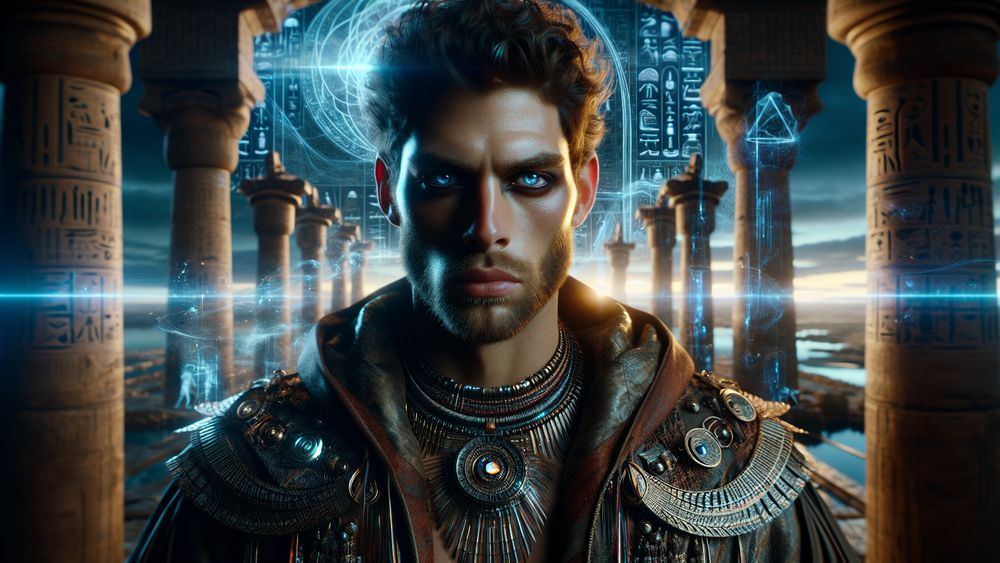
Pantheon of All the Egyptian Mythology Gods
So, we’ve got this huge family of gods and goddesses in Egyptian mythology. They’re all about different parts of life and the world. Like, there’s Ra. He’s the sun guy, making his daily trip across the sky and then heading through the underworld when it’s night. Then you have Isis. She’s all about magic and being a mom. She’s smart and kind, always looking out for her family.
And don’t forget Anubis, with his jackal head, taking care of mummification and afterlife business. Thoth is another one, the ibis-headed god who’s a whiz with writing and knowledge. This bunch and many more make up a rich and complex group that has folks still scratching their heads and wanting to learn more, even after all these years.
For those who really want to get into it, checking out a comprehensive list of all the Egyptian gods can open up a whole new world of ancient tales and wisdom that’s both deep and wide.
FAQs
1. Who were Seth’s parents and what was his place in the family of Egyptian gods?
Geb and Nut call Seth their son. They rule over the Earth and the sky. This makes Seth a key player in the divine family. He’s different, though. Known for stirring up storms and chaos, he doesn’t quite fit in with his brothers and sisters.
2. How did Seth become the god of chaos and storms?
In the heart of ancient Egyptian tales, Seth steps into the role of chaos and storms. It’s all about what he does and the symbols that cling to him. Take the story where he shakes up everything that’s stable and right in the world by going after Osiris. This act alone pins him down as the face of upheaval and wild weather. It’s his actions, really, that speak loud and clear.
They tell us, without a doubt, that when you think chaos and storms, you’re thinking Seth.
3. What are some of the most famous myths and stories involving Seth?
Seth’s story grabs us with tales where he does the unthinkable and kills Osiris. This act kicks off a huge fight for power with Horus. It’s a tale that has it all. Betrayal and a fight for what’s right mix together. Seth, in these stories, is a figure that you can’t easily forget. He brings chaos but also challenges which push others to seek justice and balance.
These narratives are key, shining a light on how Egyptians saw the world. They’re about more than just gods and power. They speak to the heart of human struggles and the pursuit of harmony.
4. How is Seth worshipped today and does he have any modern followers?
In our times, groups that honor Seth are quite unique and hard to find. They exist, though, keeping alive traditions that reach back to ancient Egypt. These folks gather in small numbers. They share rituals and make offerings that would feel right at home thousands of years ago. Yet, they do so away from the spotlight, often unnoticed by the wider world.
Their practices blend respect for the past with a touch of modern spirit. It’s a rare sight, indeed. This way of honoring Seth speaks volumes about the endurance of ancient beliefs in today’s fast-paced world.


